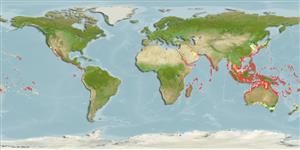Common names from other countries
Classification / Names / Names
Namen | Synonyme | Catalog of Fishes (gen., sp.) | ITIS | CoL | WoRMS
Environment: milieu / climate zone / depth range / distribution range
Ökologie
; tiefenbereich 0 - 50 m (Ref. 349). Tropical
Indo-Pacific.
Length at first maturity / Size / Gewicht / Alter
Maturity: Lm ? range ? - ? cm Max length : 33.0 cm SHL Männchen/unbestimmt; (Ref. 349); common length : 20.0 cm SHL Männchen/unbestimmt; (Ref. 349)
This large and common species is actively collected in many parts of the Indo-West Pacific realm (Ref. 349). Maximum depth from Ref. 101003. Often on clean coarse sand and rubble bottoms in which large individuals partially bury themselves. Preys on bivalves and other gastropods (Ref. 349). Damages pearl oyster beds (Ref. 799).
Life cycle and mating behavior
Geschlechtsreife | Fortpflanzung | Ablaichen | Eier | Fecundity | Larven
This species is a non-broadcast spawner. Life cycle does not include trocophore stage. Also Ref. 833.
Poutiers, J.M. 1998. (Ref. 349)
IUCN Rote Liste Status (Ref. 130435)
CITES Status (Ref. 108899)
Not Evaluated
Not Evaluated
Bedrohung für Menschen
Harmless
Nutzung durch Menschen
| FishSource |
Tools
Internet Quellen
Estimates based on models
Preferred temperature
(Ref.
115969): 22.8 - 29.1, mean 28 (based on 1524 cells).
Verwundbarkeit
Low vulnerability (23 of 100).
Preiskategorie
Unknown.
